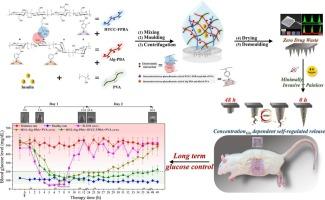Intelligent microneedle patch based on functionalized alginate and chitosan for long-term self-regulated insulin delivery
IF 10.7
1区 化学
Q1 CHEMISTRY, APPLIED
引用次数: 0
Abstract
Severely diabetic patients need insulin input to maintain the body's glycemic balance. However, traditional injection methods are often associated with poor adherence and an increased risk of hypoglycemia. Microneedle technology offers a promising solution by minimizing pain and trauma during insulin administration. Nonetheless, achieving prolonged glycemic control by microneedle with high insulin loading remains a significant challenge. Herein, we introduce an innovative microneedle patch that draws inspiration from the elegant light-induced blooming of water lily petals. The patch features a glucose-responsive hydrogel network crafted from two modified polysaccharide polymers, which enables the delivery of long-acting insulin without depending on glucose oxidase. By incorporating phenylboronic acid-modified sodium alginate, quaternary ammonium chitosan, and polyvinyl alcohol into a hydrogel matrix, we have created a microneedle system that harbors dynamic borate ester linkages and electrostatic attractions, resulting in heightened sensitivity to blood glucose levels. The electrostatic interaction acts as a relatively stable crosslinking point, balancing the dynamic reproducibility response based on the borate ester bond. This self-adaptive hydrogel can regulate insulin-controlled release by responding to changes in glucose concentration. Herein, we achieved massive insulin loading (20 IU) with long lasting glycaemic control (48 h) in a single treatment of diabetic SD rats.

基于功能化海藻酸盐和壳聚糖的智能微针贴片,用于长期自我调节胰岛素给药
严重糖尿病患者需要输入胰岛素来维持体内血糖平衡。然而,传统的注射方法往往导致患者依从性差,并增加低血糖风险。微针技术最大程度地减少了胰岛素注射过程中的疼痛和创伤,是一种很有前景的解决方案。尽管如此,通过微针实现高胰岛素负荷下的长时间血糖控制仍是一项重大挑战。在此,我们介绍一种创新型微针贴片,它从睡莲花瓣优雅的光诱导绽放中汲取灵感。该贴片具有葡萄糖响应性水凝胶网络,由两种改性多糖聚合物制成,无需依赖葡萄糖氧化酶即可输送长效胰岛素。通过在水凝胶基质中加入苯硼酸改性海藻酸钠、季铵壳聚糖和聚乙烯醇,我们创造出了一种微针系统,它具有动态硼酸酯连接和静电吸引力,从而提高了对血糖水平的敏感性。静电相互作用是一个相对稳定的交联点,平衡了基于硼酸酯键的动态再现性反应。这种自适应水凝胶可通过响应葡萄糖浓度的变化来调节胰岛素的控制释放。在此,我们对糖尿病 SD 大鼠进行了一次治疗,就实现了大量胰岛素负荷(20 IU)和持久的血糖控制(48 小时)。
本文章由计算机程序翻译,如有差异,请以英文原文为准。
求助全文
约1分钟内获得全文
求助全文
来源期刊

Carbohydrate Polymers
化学-高分子科学
CiteScore
22.40
自引率
8.00%
发文量
1286
审稿时长
47 days
期刊介绍:
Carbohydrate Polymers stands as a prominent journal in the glycoscience field, dedicated to exploring and harnessing the potential of polysaccharides with applications spanning bioenergy, bioplastics, biomaterials, biorefining, chemistry, drug delivery, food, health, nanotechnology, packaging, paper, pharmaceuticals, medicine, oil recovery, textiles, tissue engineering, wood, and various aspects of glycoscience.
The journal emphasizes the central role of well-characterized carbohydrate polymers, highlighting their significance as the primary focus rather than a peripheral topic. Each paper must prominently feature at least one named carbohydrate polymer, evident in both citation and title, with a commitment to innovative research that advances scientific knowledge.
 求助内容:
求助内容: 应助结果提醒方式:
应助结果提醒方式:


